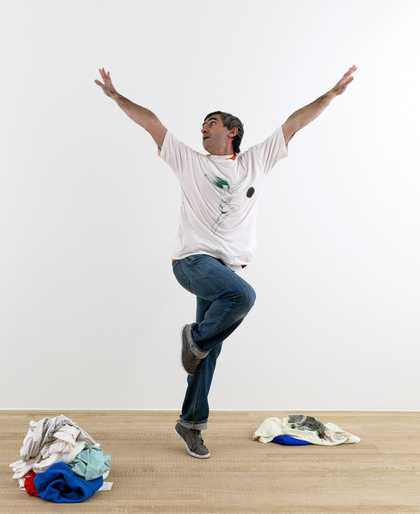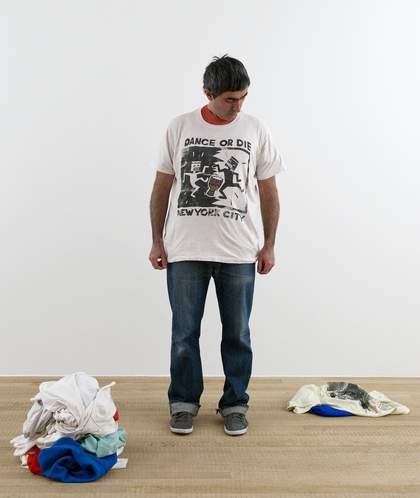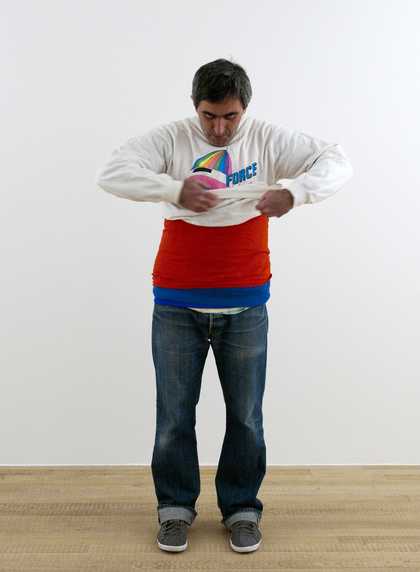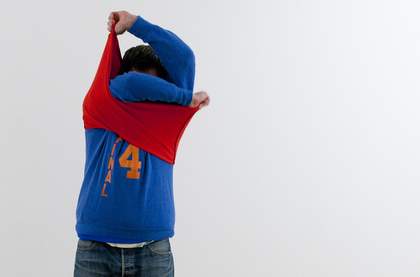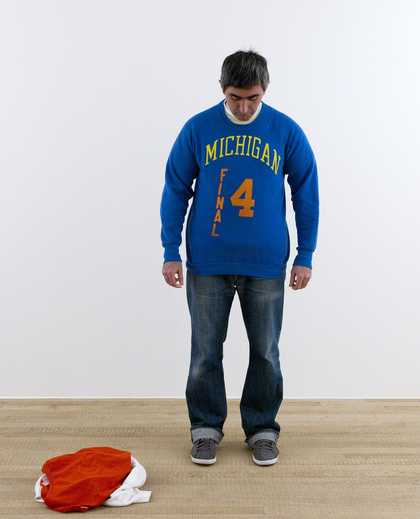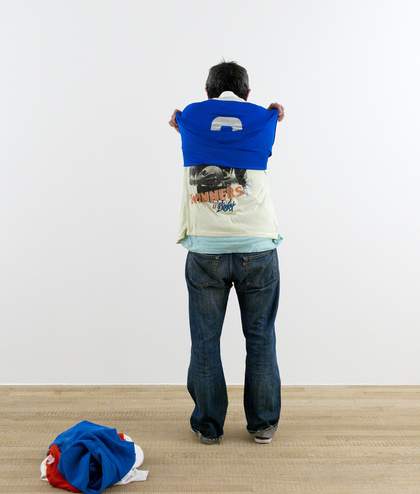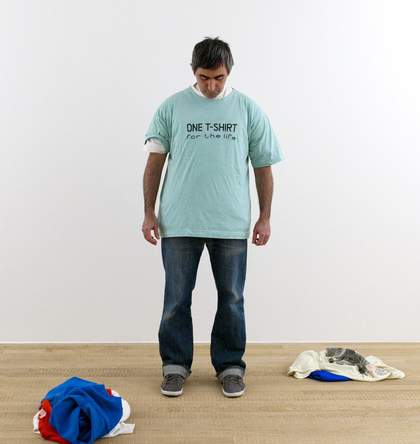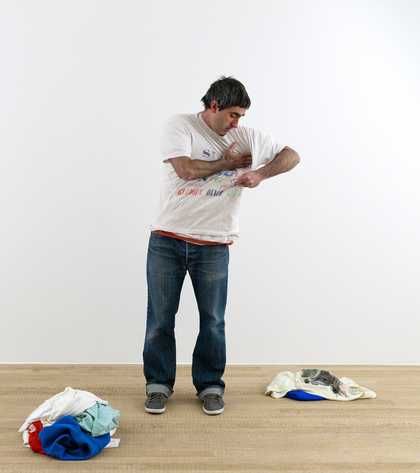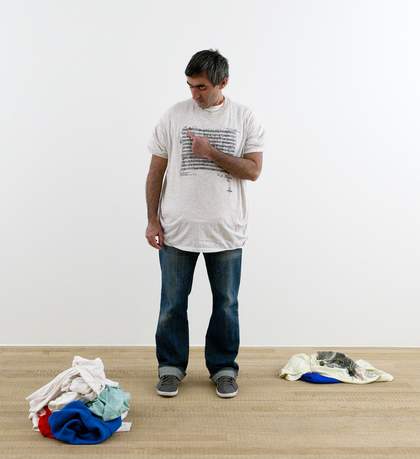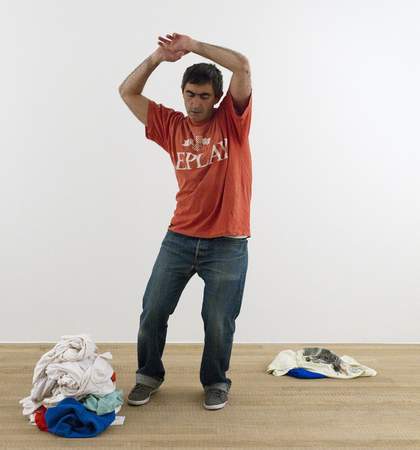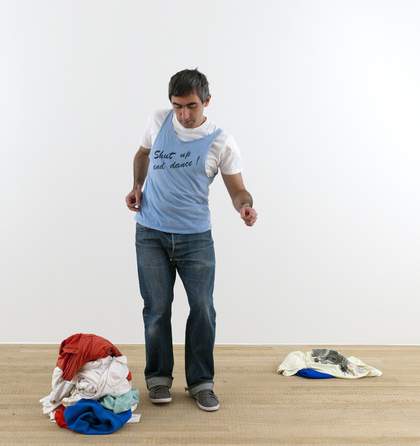Shirtology by French choreographer Jérôme Bel was the first work commissioned for the BMW Tate Live: Performance Room series, a programme of events conceived specifically for live web broadcast. Bel’s Shirtology was performed on 22 March 2012. It explored this new, experimental way of connecting performer and audience, as well as the relationships between choreography and everyday action, performance and popular culture through the simple act of changing shirts.
The first of Bel’s works to not only been screened online, but also without the physical presence of an audience, for this version of Shirtology dancer Frédéric Seguette – whom Bel has collaborated with throughout his career – enter a plain white, unadorned space, casually dressed on his bottom half in sneakers and jeans, with his upper body clad in a series of jumpers, t-shirts and vests, worn one on top of the other. Standing directly in front of the camera Seguette then removed these shirts one by one, performing a slow striptease. Each of the shirts, apart from the final five, were adorned with logos, taglines, icons or images, which Seguette paused to interpret before removing one garment and revealing the next. Occasionally the performer lingered on a particular shirt, often one referencing music, dance or performance itself, using it as a prompt for more elaborate choreographed actions. As the often highly commercialised and gimmicky symbols on the t-shirts were adopted as performative instructions, Seguette’s movements became at once more expressive and more ludicrous; a disjointed monologue of actions informed by snippets of mostly outdated advertising slogans and inane catchphrases.
In one instance Seguette paused on a t-shirt with the musical score for Mozart’s Serenade in G Minor printed on front. The dancer inspected the music and then sang each note as he traced the musical bars with his finger. He was then instructed by another logo to ‘Dance or Die’, which he interpreted through a series of clumsy moves performed to his improvised Mozart. The moves were described by Claire Bishop as ‘the kind of charmingly amateur boogie that most thirtysomethings resort to at drunken parties’.1 The next logo-emblazed t-shirt, from the fashion brand Replay, was interpreted literally, with Seguette repeating the Mozart serenade and dance moves once again. This act was adapted one last time when a t-shirt printed with the words ‘Shut up and Dance’ was revealed, at which point Seguette performed his dance routine again, without singing. Bishop commented that ‘nonvirtuosity, literalism, and drawn-out, deadpan humor’ of these repeated actions challenged any view of contemporary art and dance as elite pursuits removed from the operations and concerns of everyday life.2
However, by drawing its content from logo-printed t-shirts, Bel also grounded the actions in everyday consumerist culture. The branded slogans literally appeared like so many shirts to be put on and taken off, alluding to the superficiality of trust and belief in contemporary society. But Seguette’s placid face, which only altered as he interpreted the shirt’s instructions, also suggested that he was being manipulated. When the final five plain white t-shirts were revealed the performer seemed at a loss, his eyes were almost closed and his movements became lethargic, without any further instruction to follow he simply exited the Performance Room. Of an earlier iteration of the work, Tim Etchells has noted that in watching Shirtology the audience is exposed to the ‘ethical complexities of reading, and being read.’3 In the context of the Performance Room and an internet broadcast these complexities ran deeper, foregrounding the demands made on people to perform online for a digital economy in constant flux.
Shirtology was first performed in 1997 but has been adapted numerous times and performed around the world in both theatres and museums. Following this iteration of the work for Tate’s Performance Room, Shirtology returned to Tate Modern in May 2015, once again shifting the context and potential interpretation of the piece when it was shown in one of the public gallery spaces as part of Tate’s two-day contemporary dance programme If Tate Modern was Musée de la danse?. The blend of choreographic and artistic disciplines and references bridging the boundary between contemporary dance and performance art.
Clare Gormley
May 2016

